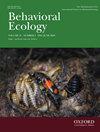Mutual mate guarding with limited sexual conflict in a sex-role-reversed shorebird
IF 2.2
3区 环境科学与生态学
Q2 BEHAVIORAL SCIENCES
引用次数: 0
Abstract
Mate guarding is typically considered a male strategy to protect paternity. However, under some circumstances, females might also benefit from guarding their mate. Female mate guarding might be particularly important in socially polyandrous species in which females compete for access to care-giving males. Because males also benefit from being near their partner to avoid paternity loss, pair members may have a mutual interest in mate guarding in polyandrous species. We studied the time spent together and movements that lead to separation, as behavioral measures of mate guarding, in the classically polyandrous red phalarope (Phalaropus fulicarius). We equipped 64 breeding pairs with miniaturized telemetry loggers with GPS to assess variation in mate-guarding intensity in relation to breeding phenology and season, nest attendance, and the occurrence of extrapair paternity. We show that red phalarope pairs were almost continuously together in the days before clutch initiation with no sex bias in separation movements, indicating mutual contribution to mate guarding. Our results suggest that in red phalaropes, both pair members guard their mate, with limited sexual conflict arising through biases in the operational sex ratio and a trade-off with male nest attendance. We found no clear relationship between mate-guarding intensity and the occurrence of extrapair paternity. In this non-territorial socially polyandrous species, mutual mate guarding might be the process underlying the evolution of a brief but strong social pair bond, with no other purpose than producing a clutch for a care-giving male.性别角色反转的滨鸟,用有限的性冲突来守护彼此的配偶
保护配偶通常被认为是男性保护父权的一种策略。然而,在某些情况下,雌性也可能从保护配偶中受益。在社会一夫多妻制的物种中,雌性保护配偶可能特别重要,因为雌性会竞争获得照顾雄性的机会。因为雄性也可以从靠近配偶中获益,以避免失去父权,在一夫多妻制的物种中,配偶成员可能在保护配偶方面有共同的利益。我们研究了典型的一妻多夫制红蝴蝶结(Phalaropus fulicarius)在一起的时间和导致分离的动作,作为保护配偶的行为措施。我们为64对繁殖对配备了微型遥测记录仪和GPS,以评估配偶保护强度与繁殖物候和季节、筑巢次数和对外父系的发生有关的变化。结果表明,在交配开始前的几天里,红色phalarp对几乎一直在一起,在分离运动中没有性别偏见,这表明它们对配偶的保护有共同的贡献。我们的研究结果表明,在红色的phalarpes中,两对成员都保护着他们的配偶,由于有效性别比例的偏差和雄性巢穴出勤率的权衡,有限的性冲突产生。我们没有发现配偶保护强度与配偶外父系的发生有明显的关系。在这种不分领地的群居一夫多妻制物种中,相互守护配偶可能是一种短暂但强大的社会伴侣关系进化的潜在过程,除了为照顾他人的雄性生产一窝卵外,没有其他目的。
本文章由计算机程序翻译,如有差异,请以英文原文为准。
求助全文
约1分钟内获得全文
求助全文
来源期刊

Behavioral Ecology
环境科学-动物学
CiteScore
5.20
自引率
8.30%
发文量
93
审稿时长
3.0 months
期刊介绍:
Studies on the whole range of behaving organisms, including plants, invertebrates, vertebrates, and humans, are included.
Behavioral Ecology construes the field in its broadest sense to include 1) the use of ecological and evolutionary processes to explain the occurrence and adaptive significance of behavior patterns; 2) the use of behavioral processes to predict ecological patterns, and 3) empirical, comparative analyses relating behavior to the environment in which it occurs.
 求助内容:
求助内容: 应助结果提醒方式:
应助结果提醒方式:


